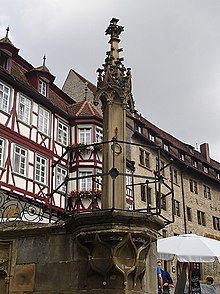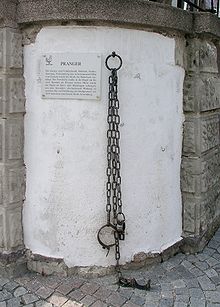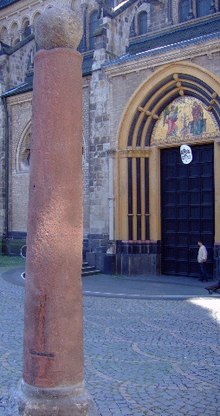pillory



The pillory, stake or kaak was a punishment tool in the form of a pillar, a wooden post or a platform on which a convict was tied up and brought before the public. Initially a torture tool and a place of corporal punishment ( stäupen ), pillory became widely used in the 13th century for the execution of honorary sentences . The pillory also served the cities as an outward sign of jurisdiction .
punishment
The punishment consisted primarily of the public disgrace which the convicted person had to endure and which in many cases made it impossible or very difficult to continue living in the community as “normal”. The punished person was also exposed to the abuse of passers-by, which was not without danger for him. Throwing objects at the person concerned and beating (Low German “kaakstreeken”, Streek = “prank” and correspondingly Danish “kagstryge”) were common. In many cities (e.g. Lübeck ), however, it was forbidden to throw solid objects at the person in the pillory (referred to here as Kaak ).
One of the last cases was probably recorded in Berlin in 1853: At the height of the reaction in Prussia, another woman was pilloried on Hausvogteiplatz for perjury :
- “... when we noticed that a curious crowd of people was crowding restlessly in front of something in front of the house bailiwick. We quickened our pace and now saw a rather elderly, corpulent woman, with her hands tied on her back to a stake that read: 'Because of perjury'. It was then written in 1853. It was therefore an attempt made at the height of the reaction to reintroduce the medieval punishment of pillory. When we stood in the same place on our way back at twelve o'clock, the spectacle, which we boys were naturally very interested in, had already disappeared from the scene. The government had probably realized that after 1848 it was no longer allowed to offer Berliners something like this. "
Designs
There are different types of pillory:
- a collar that is attached to the town hall, church or other public building with a chain
- a wooden or stone post set into the ground with a collar attached to it (stake). In northern Germany such a stake was called Kaak. On the Kaak columns in Flensburg and Tondern there were shackle figures made of copper and wood, each called Kaakmann (cf. also: Kaak (Lübeck) ). In France this stake was called poteau, in the Netherlands shandpaal .
- a pillory, a stool, or a shameful donkey was a wooden frame that stood in a public square. The victim had to sit on it ( donkey ride ).
- A cage for standing and sitting in public places. Such is still on the market today the city Leutschau (Levoča) in Slovakia and in Möhringen on the Danube .
- This also includes the blasphemy .
distribution
- In England and its former colonies, a distinction is made between the permanently erected pillory (from Latin pila = pillar, column) and the movable and less humiliating stocks , in which the hands of the punished person were trapped (compare also the German stick or foot block).
- The pilori in France was a permanently erected, small tower with a ring made of wood or iron for the head and arms, often still attached to a turntable in order to be able to expose the punished to all sides. Probably the only surviving pilori in the form of a column (8 m high), similar to the one in Wroclaw, is located in the main square of Braine-le-Château near Brussels.
- In Spain there are court pillars ( rollo or picota ) in many small towns in Castile . Mostly they are on the main square (e.g. Guadamur ), but in some cases also a little outside the village (e.g. Berlanga de Duero ). What they all have in common is a stepped plinth; many have a plate extending in four directions above the mostly articulated shaft and below the "crown".
- In Portugal and its former colonies, many pelourinhos have been preserved, typically in the main square or in front of a church or palace (e.g. in Cidade Velha in Cape Verde ). In Salvador da Bahia , the former colonial capital of Brazil, the entire old town is now called " Pelourinho ".
- In ancient China , Japan and Korea , a square wooden board with a circular opening for the neck, the so-called wooden collar ( Chinese 項 鎖 , Pinyin ànsuǒ - "neck cuff "; Korean 칼 kal ; Japanese 首 枷 kubikase , German "neck fetter" ) was used. There were versions for only one punished person or for several. In Europe, such devices were known as the neck violin .
Enzersdorf im Thale - pillory
Berlanga de Duero - rollo or picota
Pillory in Breslau (Wrocław)
Pillory in Grüssau (Krzeszów)
Pillory at the town hall in Sursee , Switzerland
Pillory in Treffurt (Thuringia)
Pillory in Portugal - Pelourinho
block

The block, probably the most common form of pillory, usually consisted of two parallel boards, which were connected to one another by a hinge and attached to the end of a strong post. There were recesses in both boards for the neck and, to the left and right of them, for the wrists. The closed boards now tied the offender around the neck and hands. Equipped in this way, it was then exhibited in public places.
Famous cases
One of the most prominent figures in the pillory was the English writer Daniel Defoe , who was pilloried in London in 1703 for his satires. His poem Hymn to the Pillory, however, spoke to the audience so from the heart that they pelted them with flowers instead of the usual windfalls and stones, and drank to their health.
"Put in the pillory"
In a figurative sense, "to pillory" means to publicly expose someone quasi-institutionally. The National Socialists used the term, for example, in their inflammatory radio program magazine Der Deutsche Sender . The rubric in which the editors critically dealt with past radio broadcasts was called “Funk-Panger”.
today
Despite the modern outlawing of the pillory, similar forms of public display still exist: Actual or alleged criminals (often with a picture or name) are displayed in the media. In the USA, lists of offenders (e.g. “ sex offender registries ” for sex offenders ) with their full name, address and photo are now officially published by the authorities . In the context of so-called “creative sentencing”, especially in the United States, there is an increasing number of alternative guilty verdicts, including public denunciation of the convicted. Punishments that aim to create shame, so-called "shaming punishments", are common. Although the constitution forbids extraordinary and cruel punishments ("cruel and unusual punishments"), dishonor is not considered cruel according to the highest legal opinion. A case in the US state of Ohio also received media attention , in which a woman was sentenced by the court to hold up a sign saying "Only an idiot would overtake a school bus on the sidewalk" for an hour twice.
The legal basis of "online pillory" as they u. a. by the Bavarian State Office for Health and Food Safety and the State Office for Nature, Environment and Consumer Protection in North Rhine-Westphalia to publish violations of food law is controversial.
Furthermore pillory and related constructs are used in the field of BDSM .
See also
swell
- Grete Bader-Weiß & Karl-Siegfried Bader: The pillory. A punitive tool and legal landmark of the Middle Ages, Freiburg i.Br. 1935.
- Richard Dülmen (ed.): The emergence of early modern Europe. 1550-1648. Fischer Weltgeschichte, Volume 24, p. 239, 9th edition, Frankfurt am Main, Fischer Taschenbuch Verlag, 2000.
- Konrad Fuchs, Heribert Raab: Dictionary of history. DTV, Munich 2001, p. 631
- Lutz Röhrich: Lexicon of proverbial sayings . Volume 4 p. 1196, Herder, Freiburg 1994
- Paul De Win: De schandstraffen in het wereldlijk strafrecht in de Zuidelijke Nederlanden van de Middeleeuwen tot de Franse Tijd bestudeerd in Europees perspectief, Brussels 1991, pp. 96-179 [Verhandelingen van de Koninklijke Academie voor Wetenschappen, Letteren en Schone Kunsten van Belgie , Class of letters, vol. 53, no. 139.]
Web links
- Historical and present pillory
- Research project on the history of pillory punishment and other shameful punishments
Footnotes
- ^ Johannes ES Schmidt: The French Cathedral School and the French Gymnasium in Berlin. Student memories 1848–1861. Edited and commented by Rüdiger RE Fock. Publishing house Dr. Kovač , Hamburg 2008, ISBN 978-3-8300-3478-0 . P. 35
- ^ Andreas Oeding, Broder Schwensen, Michael Sturm: Flexikon. 725 aha experiences from Flensburg !. Flensburg 2009, article: Kaakmann
- ↑ Nordfriesland, Tønder DK , accessed on November 14, 2015
- ↑ Der Deutsche Sender, 9.1933, leading article "Divorce of spirits"
- ↑ Süddeutsche Zeitung: Strict US judges: disgrace in front of the supermarket
- ^ The Shame Game The New Republic, March 10, 2016; other places with criminal lists
- ↑ Alternative punishments in America: In the pillory. In: Cicero. Retrieved December 7, 2018 .
- ^ Spiegel Online: On the modern pillory - "idiot" punishment for traffic offenders
- ↑ Internet pillory of the State Office for Health and Food Safety ( Memento of the original from January 16, 2013 in the Internet Archive ) Info: The archive link was inserted automatically and has not yet been checked. Please check the original and archive link according to the instructions and then remove this notice.
- ^ VG Aachen: Admissibility of Internet pillory for bakery








